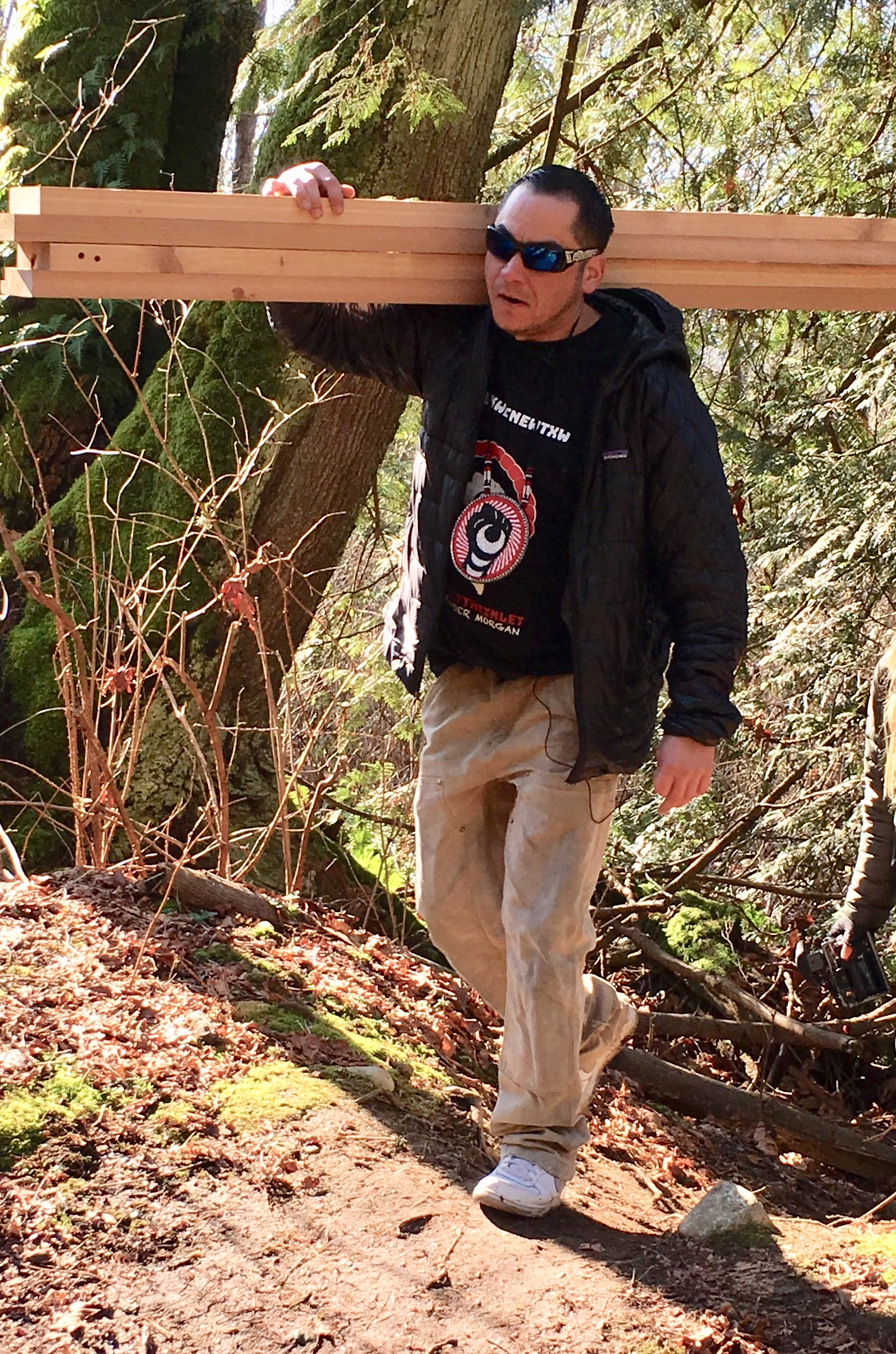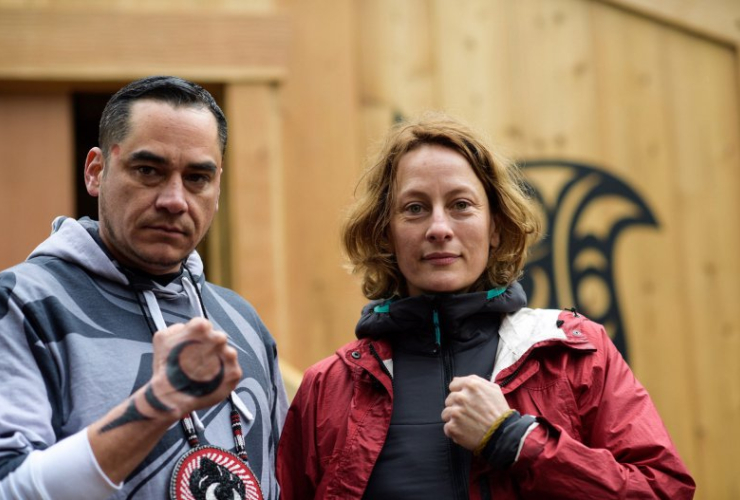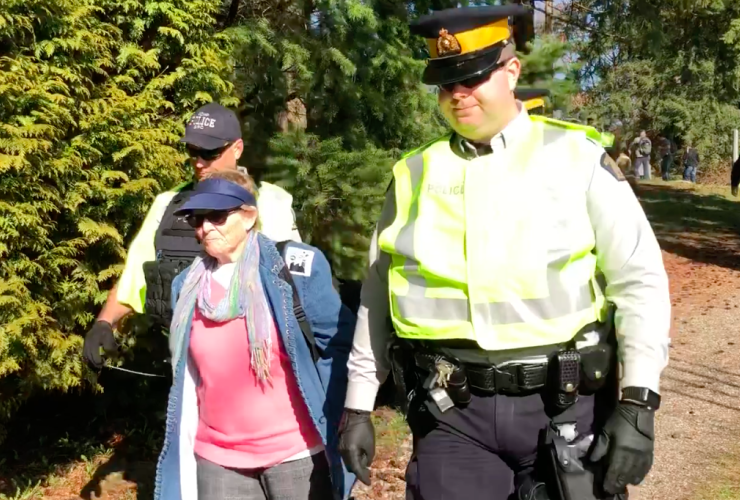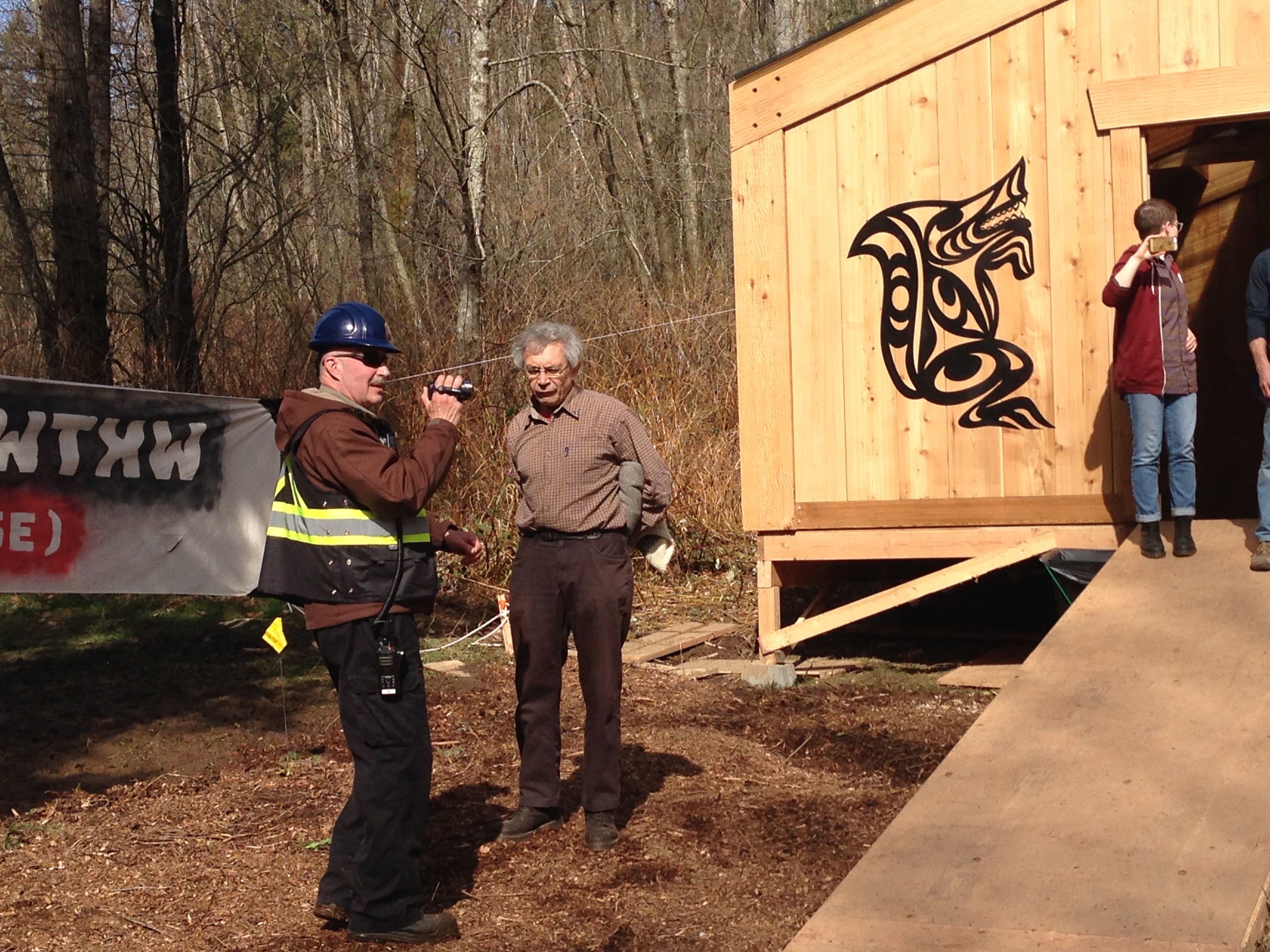Two Saturdays ago, at dawn, on a wooded trail 100 yards south of the Kinder Morgan oil facility in Burnaby, a stone’s throw from where protestors were gathering for a large protest rally, another group began to build a house.
They were helping to raise a Watch House – the spiritual and ceremonial hub for the next wave of protests against Kinder Morgan’s hotly contested oil pipeline. The Watch House build on March 10th marked the beginning of Kwekwecnewtwx (pronounced: Kwe-kwetz-ow-tukh), which in Coast Salish means ‘a place to watch from.’
The Watch House is something new, both in the Kinder Morgan fight and in protest politics. Its presence is at the very heart of what could become Canada’s Standing Rock. At the same time, it is emerging as a place to reconcile differences, as Indigenous and non-Indigenous gather under its roof, closely plan together, and base their actions in the teachings and leadership of the original peoples of the coast.
Initiated by members of the Tsleil-Waututh Nation, whose name means People of the Inlet, the Watch House resistance is backed by members of the Squamish and Musqueam nations and environmental groups, including Stand.earth, Greenpeace and 350.org.
At dawn, as protestors carried Watch House lumber from soccer field to wooded trail, there was much stomping of feet to ward off cold, and quiet laughter, but also a sense of engaged seriousness. This was a stealth operation. Builders quickly laid cement corner stones, pre-cut to hold foundation planks. Then, up went the structure over the course of a single day — each piece drawing murmurs of appreciation.
Because make no mistake: the Watch House is beautiful. Designed with traditional longhouse elements, the wood was cut from a single red cedar tree, fifty feet long, and milled by Indigenous woodworkers in nearby Sechelt. Up close, I marvelled at how neatly beams and cross-pieces had been predrilled and notched.

Rueben George, a Tsleil-Waututh member, talked to me five days after the Watch House went up. He said it came from a vision that his uncle, the late Leonard George — the son of Chief Dan George — had three years ago about a return of Watch Houses to Coast Salish land. When he died last year, elders felt moved to follow Leonard George’s vision.
One of these elders was Amy George, Rueben’s mother, affectionately known as Ta’ah, (grandmother) by many in the Tsleil-Waututh and in her extended community. As well as supporting the Watch House, she famously told her people, at the time of possible accommodations with Kinder Morgan, that negotiation was impossible when oil spills could devastate their territory and waters.
“She told us to ‘Warrior up!’ Rueben George said. “Those were her words. And that’s what we’ve been doing ever since.” The Tsleil-Waututh’s referendum passed unanimously against a negotiated settlement with Kinder Morgan.
“Watch Houses are key to our culture,” Rueben George said. “We used to set them up high to look over lands and water and protect us. But they’re also spiritual and ceremonial. Nothing will go wrong at the Watch House. It is a respectful place that has been much talked over by our elders. Whatever comes next, we want to do it in a good way.”
And what has come next?
In the two weeks since the build, 172 people have blockaded the gates of Kinder Morgan, often stopping large work trucks from entering for many hours. All have been arrested for crossing the five metre injunction line. All have been charged with civil contempt. They include two opera singers, a former Trans-mountain pipeline engineer, a Metis grandmother, a 76-year-old Montessori school teacher, and a husband and wife team, arrested on two separate Saturdays in order ‘to take turns watching the baby.’
Also arrested were Elizabeth May, head of the Green Party of Canada, and Kennedy Stewart, Member of Parliament for Burnaby South.
They all began their day by marching to the Watch House. There, under the gaze of two bas-relief wolf carvings on the Watch House walls (Tsleil Waututh symbols of protection), the blockaders received words of empowerment from Will George, a cousin of Rueben George, and the Kwekwecnewtwx representative at the Watch House.

Will is a warm and naturally polite man in his 30s, who for sixteen years was a window-cleaner of downtown Vancouver skyscrapers, including Trump Tower. I spoke to him as we walked on the beach near the Tsleil-Waututh reserve. It was a bright day, the inlet blue and beautiful, and on the other side we could clearly see the oil holding tanks of the Kinder Morgan Westridge facility.
“A lone messenger used to run from village to village, warning people about coming enemies. I am so proud to be that messenger now. I am so proud to be that warrior. But I could never do it without the support of my elders and spiritual leaders.”
When I asked about the spiritual power of the Watch House, he said: “People were so afraid of our spirituality, they wanted to destroy it. But they couldn’t — and in the end the spirituality of our people is going to be what guides us all forward.”
We paused on the beach and Will told me that Tsleil-Waututh children often collect the arrowheads and spearheads that are found in the sand. Some kids have a drawerful. His people have lived here for 30,000 years: their traces are everywhere. It was moving to think of that long sojourn in this inlet. How such constancy has nourished the Tsleil-Waututh love for the inlet, and their intention to protect it.
“I’m doing this for my son,” he said with a smile. “But I’m also doing it for Justin Trudeau’s children.”
The ceremony at the Watch House has had a deep affect on many of the blockaders, including Anne Relyea, a retired opera singer, arrested on Wednesday, March 21st with her husband Gary and a dozen others. “Will George’s words were so heartfelt and so haunting. He said he was grateful to us, and the way he communicated it — it felt both powerful and very kind.”
Megan Bryden, who lives in the Whattlekainun Housing Co-op five hundred metres from Kinder Morgan’s gates, says the Watch House has definitely been a hopeful development for her family. “Kinder Morgan is a dangerous place to live near,” she said, mentioning the Burnaby Fire Department’s submission to the National Energy Board. It recommended strongly against the expansion, raising alarms about dangers of sulphuric gases, explosion and fire, and the impossibility of safely evacuating residents because of limited road access.
“They (Kinder Morgan) don’t inform us of tests. They have a jet fuel line that runs directly under our street. My children play on the trails. But with the Watch House — it feels like somebody finally has our backs.”
Five days after the Watch House build, I visited Rueben George and his son, Cedar Parker-George, in Rueben’s back yard in East Vancouver, where they were working together on a ceremonial drum, soaking a hide to stretch on a frame. Cedar explained he was in ceremony and could not shake hands, or discuss any aspect of the ceremonial. However, he did talk about the diverse movement that is building against Kinder Morgan.
“When my grandmother, my Ta’ah, went into residential school, they told her, ‘when you leave here, nothing will be Indian but your blood.’ But they were wrong, because look at us now, our beliefs are taking us to new heights, and we’re going to stop this pipeline. They were so afraid of our differences. But now I see this movement, and we’re all different. Different skins. Different religions. Our differences have become our strengths.”
Shaena Lambert is the author of three books of fiction, Oh, My Darling, Radiance and The Falling Woman. All three were selected as top books of the year by the Globe and Mail. She lives in Vancouver.
Follow the Justin Trudeau
Follow the Justin Trudeau Brigade on FB.....& the Tiny House Warriors





Comments